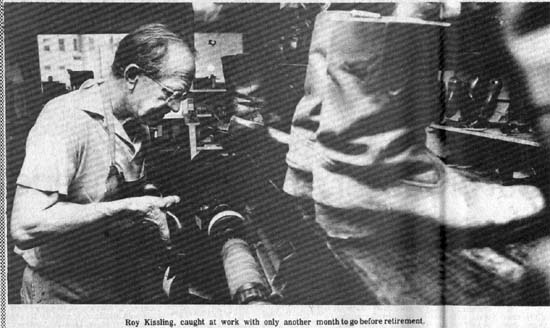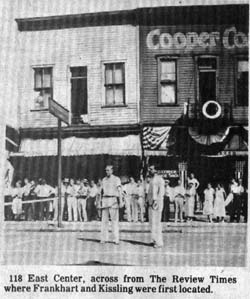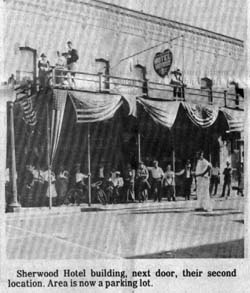August 30, 1979



Picture #1 – Roy Kissling, caught at work with only another month go go before retirement.
Picture #2 – 118 East Center, across from The Review Time where Frankhart and Kissling were first located
Picture #3 – Sherwood Hotel building, next door, their second location. Area is now a parking lot.
When Roy Kissling, Fostoria’s oldest cobbler takes off his apron on Sept. 29 he will not hang it up with the expectation of putting it on again the next day, because he’s retiring from the shoe repairing business after 41 years.
Kissling started part-time in the business at Kansas, in 1938, when he was also working at The Auto Lite.
In 1944, he joined Dave Frankhart, as a partner. Frankhart was already in business in the frame building, now remodeled in which Yonker Insurance is located at 118 E. Center St. The one accompanying photo shows the building then.
Carl Herbert had a tire shop in the building at one time, and George Brazlem another shoe cobbler had his shop there prior to moving across the street.
In 1947, Kissling and Frankhart moved next door to the Sherwood Hotel building. Their new location was earlier the Tasty Treat Restaurant, owned and managed by Glenna.
When Frankhart and his son drowned, while fishing at a Fostoria Reservoir, Kissling became sole owner of the business. He stayed at the East Center Street location until 1960, when he had the building erected for his shop at 130 W. Center St., where he has been ever since.
MANY CHANGES THROUGH YEARS
Asked what changes have taken place in the shoe repair business since he started, Roy replied, “There’s less of it. At one time there were eight shoe repair shops here…Joe Brown, George Brown, Mike Brown, Dave Frankhart, John Saddoris, Theo Hummer, Mr. Taylor, and George Brazlem. At one time children’s shoes were the big repair item, he said, but now the kids wear tennis shoes, sandals, and all kinds of novelty shoes which usually can’t be repaired.
The man-made materials have also cut deeply into the all-leather shoe market, and likewise the repair business…Kissling believes as much as 35 percent.
There was a time when every town, no matter how small, usually had at least one shoe repair shop, but no more. Kissling has maintained a good level of business by drawing trade from surrounding area where shops no longer exist. He has also supplemented his business by repairing zippers, and other leather items.
What are you going to do when you retire, I asked Roy, Well my wife and I will be doing some furniture refinishing, we will also continue to restore our house at 200 W. Tiffin St., and I want to get in some fishing, was his reply.
RECOLLECTIONS OF OLD DAYS
After talking with Kissling and at home looking at my notes, I reflected on other changes in the shoe and repair business in the last 50-60 years.
I recalled the high button shoes the ladies wore, and how they used to buttonhook to button them up. I also recalled the high-top shoes that every kid wanted when I was young. They laced up 8-9 inches and had buckles at the top. We waterproofed out leather shoes with heated mutton tallow, gotten at the butcher shop. there were also the redtop rubber boots every kid envied.
Then, our all-leather shoed were always soled and heeled, and stitched and patched to last as long as possible. We sometimes had only one pair of shoes at a time, and kept them shined for Sunday. If we had two pair of shoes the one pair was strictly for Sunday.
Then, too I recall that some of the old-time cobblers could actually make a pair of shoes…and that prompted me to recall the song us kids learned in grade school:
There’s a little old man,
in a little old house,
lives over the way, you see
He sits at his window
the life long day
making shoes for you and me
with a rat-a-tat-tat
and a rat-a-tat-tat,
and a rat-a-tat-tat-tat-tee
making shoes for you and me.
Take a good look at the photos of Kissling, taken on one of his last days in his shop. That’s one of the ways you’ll remember him, because he won’t be repairing shoes anymore.
Pete DeCesare will be the only shoe repairman left in Fostoria.
READER FEEDBACK – CARBON STORY
That story sold lots of extra copies, which were sent to Carbon people scattered all over. The one girl that was not identified in the picture of Carbon office girls was Doris Weaver, identified by Fred Roberts, a retired Carbon employee.
JONES ROAD
After the article about Jones Road went to press, I had a call from my old school teacher, Edna Hatfield, who had provided some information for the article. The next day at her home, she said the article was good, but I had made a “bad mistake”. I said Lloyd Hatfield’s widow in Clearwater, Fla., was a daughter of J.P. Bower. It should have said Lloyd Bower, and his wife Gladys (Hatfield) was a sister of Chalmer Hatfield, sister-in-law of Edna Hatfield. Gladys (Hatfield) Bower was a granddaughter of Gideon Jones. I regret the error. It was a misunderstanding on my part.
BASKET MARKET
Also, in that same article, under Reader Feedback, I reported on the location of The Basket Market. Several readers called me about it, saying they believed I had mistakenly identified its location. I am investigating that and will report later.